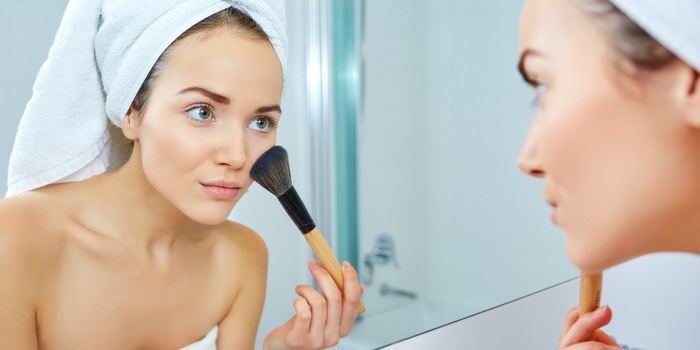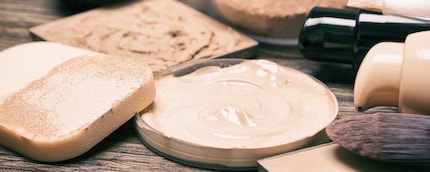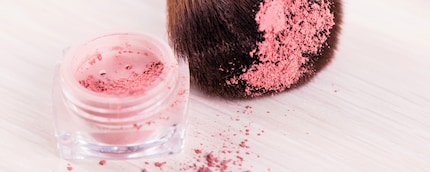
Beauty classics explained: Foundation
Foundation forms the basis of a successful make-up look - whether it's an evening or daytime look. But how do you choose the right shade and apply it correctly? In five simple steps, you can create the basis for an even complexion - without the typical mistakes.
Every month you will find new tips, dos and don'ts, product recommendations and other interesting facts about a beauty classic on our website.
Once you have found the right foundation and applied it correctly, your face will look fresher, more even and therefore younger. The best make-up foundation is only as good as how you apply it. Getting the desired complexion is easier said than done. It is not uncommon to accidentally buy a foundation that is too light or too dark. Once you have found the right colour, unwanted redness and spots can still show through. So how do you apply the right foundation?

Finding the right foundation: Spoilt for choice
Once you have found the right foundation, it makes the skin smooth and even. But that's where the difficulty lies. From tinted day cream to liquid foundation or mineral powder, the beauty market has a lot to offer.
I recommend that you test the foundation directly on the lower half of your face when choosing a colour. Because nothing is worse than having a white neck and a suspiciously dark head with visible edges. Important here: look at the colour in daylight.
When choosing foundation, you should not only match the colour shade to your skin type, but also the consistency. Liquid foundations are particularly suitable for women with normal or drier skin. However, if you tend to have oily skin, you should opt for powder foundation. This mattifies the skin and reduces the oil content.
For combination skin, the forehead and nose area is slightly more oily, while the rest of the face is rather dry. It is therefore best to mix different types of foundation for this skin type. Avoid the forehead and nose area when applying foundation. You can then make them up with powder foundation.
Mousse foundations are best suited to dry skin or skin that is already showing the first signs of wrinkles. The mousse is applied in thin layers and can be used more or less thickly depending on your skin type. If you prefer a more subtle look, you can use a tinted day cream as a foundation. The tinted cream, also known as BB or CC cream, not only gives you a natural complexion, but also moisturises your skin.
Another foundation method is the mineral foundation. This is particularly suitable if you have very sensitive skin. No chemical additives are used in its manufacture, making it particularly well tolerated.
Applying foundation correctly: step-by-step guide for a radiant complexion
Step 1: Cleansing before application
If your skin is well cared for and free of dead skin cells, it forms the perfect base for the foundation to follow. That's why it's best to exfoliate your facial skin weekly and cleanse it thoroughly before applying foundation. Before moving on to the next step, don't forget to moisturise. Not only will the next step last longer, it will also dry out the skin less.

Step 2: Smooth out small blemishes
Cover up small skin imperfections with a concealer. A yellow-tinted concealer covers dark circles and bluish areas of skin. The green corrective pencil is suitable for redness and blemishes. Have you covered everything? - Then go for the foundation!

Step 3: Apply foundation
When applying liquid foundation, it is best to use a moistened beauty blender. If you are using powder, use a suitable brush. Start applying in the centre of your face. This is where the skin often tends to redden and discolour. Spread the foundation from the centre outwards to avoid unsightly edges. To emphasise certain areas of your face, you can use other make-up or powder in a darker or lighter shade. As a general rule: use darker shades to create depth and lighter shades to emphasise areas.
Step 4: Set with powder
Apply your powder to your forehead, chin and cheeks in light circular motions until your complexion is beautifully mattified. Do not apply full coverage to achieve a luminous effect. If you want to apply lipstick afterwards, you can dab your lips lightly - this will help the colour to last longer.
Step 5: Let the complexion shine
Give your complexion the finishing touches. After foundation and powder have been applied, blusher on the cheeks looks fresh and radiant. The best way to do this is to apply the blusher slightly below the cheekbones using a brush. Make sure that you don't apply it too far down and not too far towards the mouth. Highlighter on the upper cheekbones, the bridge and wings of the nose and above and below the eyes also set the final accents. With blusher and highlighter, it is important that the consistency matches your foundation. This is because powdery products hold better on the same base than liquid ones and vice versa.

Inspired? Get to your brushes!
To the entire complexion range
Friends, family, cats and good wine are my lifeblood.